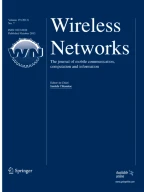Abstract
Energy is a scarce resource in the battery-powered nodes of wireless sensor networks (WSNs). In this paper the energy utilization for WSN based on BPSK communications has been investigated over the Generalized-K shadowed fading channel. A comprehensive analysis is reported based on the various important performance metrics like: amount of fading, average bit error probability, outage probability and energy utilized per bit (EUB). Simulation results reveal that composite use of shadowing and fading degrade energy levels to a considerable extent and hence contribute in downsizing the network life-span. We have derived the EUB metric and performed its evaluation with respect to optimal transmit energy levels by varying fading and shadowing severity parameters. We also considered the impact of varying transmit energy levels on the outage probability and hence on transmit and EUB levels. Although, embedding of training sequences and re-transmissions do help in enhancing effective synchronization and improved reliability, but this is done at a cost of higher energy utilization. Under the given set of assumptions, it is observed that an decrease in fading by about 11 %, improves the EUB by about 7 %. With increase in outage probability by about 10 %, EUB improves by about 3 %. An increase in SNR by 6 % improves the EUB levels by about 7 %. The investigations reported in this paper may enable designers to optionally choose suitable parameters to make WSN communications energy-efficient.
Similar content being viewed by others
References
Amiri, S., Saidi, H., Ghiasian, A., & Hashemi, M. R. (2011). Enhanced lifetime maximization algorithm for wireless sensor network. In 7th International Wireless Communications and Mobile Computing Conference (IWCMC), 4–8 July (pp. 302–307).
Madan, R., & Lall, S. (2006). Distributed algorithms for maximum lifetime routing in wireless sensor networks. IEEE Transactions on Wireless Communications, 5(8), 2185–2193.
Shankar, P. M. (2004). Error rates in generalized shadowed fading channels. Wireless Personal Communication, 28(3), 233–238.
Bahl, N., Sharma, A. K., & Verma, H. K. (2012). Impact of physical layer jamming on wireless sensor networks with shadowing and multicasting. International Journal of Computer Network and Information Security, 4(7), 51–56.
Bithas, P. S., Sagias, N. C., Mathiopoulos, P. T., Karagiannidis, G. K., & Rontogiannis, A. A. (2006). On the performance analysis of digital communications over generalized-k fading channels. IEEE Communications Letters, 10(5), 353–355.
Malhotra, J., Sharma, A. K., & Kaler, R. S. (2008). On the performance analysis of wireless receiver in cascaded fading channel. African Journal of Information & Communication Technology, 4(3), 65–72.
Cui, S., Goldsmith, A. J., & Bahai, A. (2005). Energy-constrained modulation optimization. IEEE Transactions on Wireless Communications, 4(5), 2349–2360.
Ammer, J. and Rabacy, J. (2006) The energy-per-useful-bit metric for evaluating and optimizing sensor network physical layers. In Sensor and ad hoc communications and networks, pp. 695–700. SECON ’06. 2006 3rd Annual IEEE Communications Society on, volume 2.
Mukesh, S., Iqbal, M., Jianhua, Z., Ping, Z., & Inam-Ur-Rehman. (2007). Comparative analysis of M-ary modulation techniques for wireless ad-hoc networks. In IEEE Sensors Applications Symposium, SAS '07 6–8 Feb (pp. 1–6).
Chouhan, S., Bose, R., & Balakrishnan, M. (2009). Integrated energy analysis of error correcting codes and modulation for energy efficient wireless sensor nodes. IEEE Transactions on Wireless Communications, 8(10), 5348–5355.
Costa, F. M., & Ochiai, H. (2010). Energy optimization for reliable point-to-point communication in energy-constrained networks. In Vehicular technology conference (VTC 2010-Spring), 2010 IEEE 71st, (pp. 1–5).
Chen, Y., Gün Sirer, E. and Wicker, S. B. (2003) On selection of optimal transmission power for ad hoc networks. In Proceedings of the 36th Annual Hawaii international conference on system sciences (HICSS’03)—Track 9—Volume 9, HICSS ’03, p 300.3, Washington, DC, USA. IEEE Computer Society.
Holland, M., Wang, T., Tavli, B., & Seyedi, A. (2011). Optimizing physical-layer parameters for wireless sensor networks. ACM Transactions on Sensor Networks, 7(4), 28.1–28.20.
Abdi, A. and Kaveh, M. (1999) On the utility of gamma pdf in modeling shadow fading (slow fading). In Vehicular technology conference, 1999 IEEE 49th, volume 3, pp. 2308–2312.
Bithas, P.S., Sagias, N.C., Mathiopoulos, P.T., Karagiannidis, G.K. and Rontogiannis, A. (2005) Digital communications over generalized-k fading channels. In Wireless communication systems, 2005. 2nd International Symposium on, pp. 684–687.
Ardid, M. L. J., Sendra, S., & Rodrigues, J. J. P. C. (2012). Underwater wireless sensor communications in the 2.4 ghz ism frequency band. Sensors, 12, 4237–4264.
Jeffrey, A., & Zwillinger, D. (2007). Table of integrals, series, and products. Table of integrals: Series, and products series. Elsevier Science.
Shankar, P. M. (2007). Outage analysis in wireless channels with multiple interferers subject to shadowing and fading using a compound pdf model. International Journal of Electronics and Communications, 61(4), 255–261.
Vilaipornsawai, U., & Soleymani, M. R. (2003). A novel turbo coding scheme for satellite atm using reed-muller codes. IEEE Transactions on Communications, 51(5), 767–773.
Proakis, J., & Salehi, M. (2007). Digital communications. McGraw-Hill higher education.
Vazifehdan, J., Prasad, R. V., Jacobsson, M., & Niemegeers, I. (2012). An analytical energy consumption model for packet transfer over wireless links. IEEE Communications Letters, 16(1), 30–33.
Du, Z., Cheng, J., & Beaulieu, N. C. (2004). Asymptotic ber performance of ofdm in frequency-selective nakagami-m. Channels, 1, 612–615.
Author information
Authors and Affiliations
Corresponding author
Rights and permissions
About this article
Cite this article
Bahl, N., Sharma, A.K. & Verma, H.K. On the energy utilization for WSN based on BPSK over the Generalized-K shadowed fading channel. Wireless Netw 20, 2385–2393 (2014). https://doi.org/10.1007/s11276-014-0743-9
Published:
Issue Date:
DOI: https://doi.org/10.1007/s11276-014-0743-9
